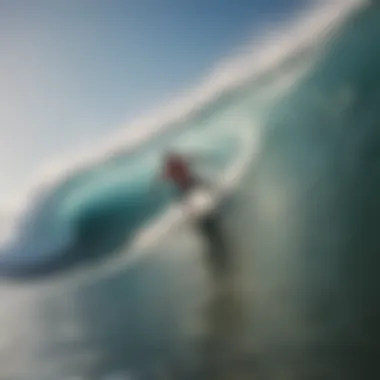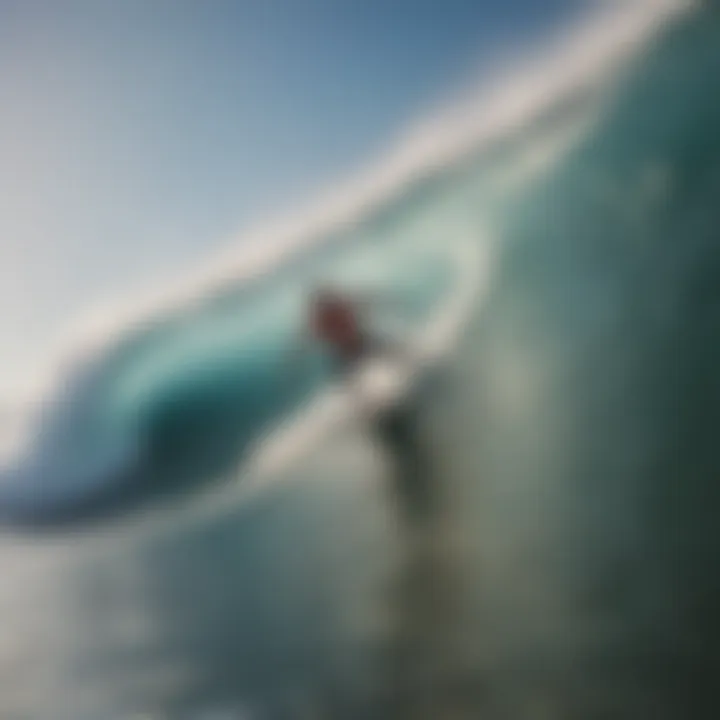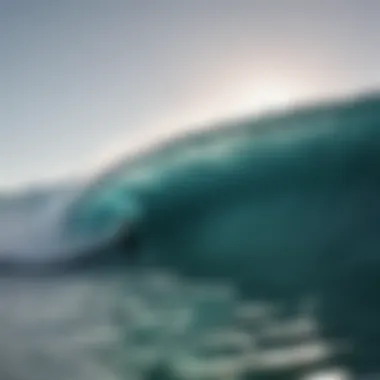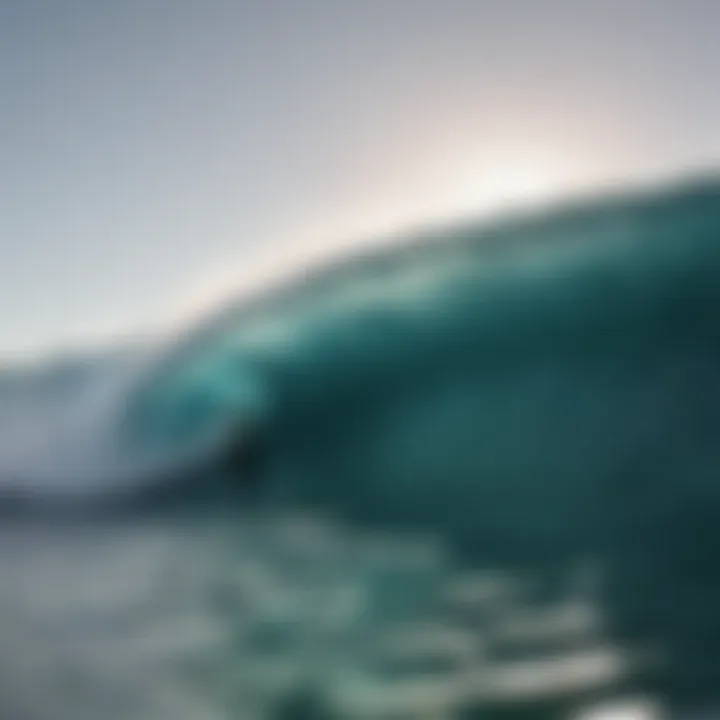Rip Curl Layday: Surf Culture Meets Technology


Intro
In the vibrant world of surfing, where the rhythm of the ocean meets the heart of the surfer, events like the Rip Curl Layday stand as a testament to the evolution of surf culture. These gatherings not only bring together enthusiasts of the sport, but they also showcase how technology has carved a niche in this age-old practice. Here, we will unpack the layers of significance within the Rip Curl Layday, illustrated by the blend of the community spirit and cutting-edge innovations that redefine our connection to the waves.
By diving deep into the history surrounding these events, we can trace how surfing has transformed from a traditional pastime to a technologically augmented adventure. Laydays, typically marked by fluctuating surf conditions, have called upon athletes and fans alike to adapt, demonstrating an inherent agility that mirrors the nature of the ocean itself.
This exploration takes us through the heart of surf techniques, the vital safety priorities that underscore any water-related activity, as well as gear recommendations that address the specialized needs of each adventurer. Whether you are starting as a novice or taking a deep plunge into advanced maneuvers, understanding the mechanics of surfing enriched by technology offers invaluable insights.
Ultimately, this narrative strives to connect the dots between the past and present within surf culture while emphasizing community engagement and environmental considerations. It’s not just about the individual; it’s a shared experience—one that resonates across generations and geographies.
Like waves, navigating through this discourse requires a nuanced understanding of both the art of surfing and the impact of modern technology. Buckle up and prepare for a ride through the tides of Surf Culture and Technology.
Understanding Rip Curl and Its Legacy
Rip Curl stands as a beacon in the surfing world, symbolizing a unique blend of passion, innovation, and dedication to the culture. This section digs into what makes Rip Curl not only a brand but a cornerstone of surf history. The legacy encompasses more than just fashionable swimwear; it's about the stories woven through it—each wave ridden assimilates the spirit of adventure and the connection between the ocean and the surfer.
Foundation and Growth of Rip Curl
Founded in 1969 by two surfers, Doug Warbrick and Brian Singer, Rip Curl was born out of a sincere love for riding waves. Initially, it started as a small shop in Torquay, Australia, selling wetsuits. The innovative designs quickly caught on with the local surfing community, and soon, the business began to expand. Today, Rip Curl is recognized worldwide. From the humble beginnings in a beach town, it has transformed into a global enterprise, catering to the diverse needs of surfers, whether they crave high-performance competition gear or casual beachwear.
Rip Curl's emphasis on product quality and functionality paved the way for its success. As surfing evolved through the decades, so too did the brand, constantly pushing the envelope with innovations like the Ripple wetsuit. These early efforts didn't just change the game for their customers but set standards across the industry. It's as if each development was a small victory, carving out Rip Curl's space in surf culture alongside traditional rivals.
What truly resonates with enthusiasts is Rip Curl’s commitment to the lifestyle surrounding the sport. Sponsoring events like the Rip Curl Pro, the brand continues to emphasize its dedication to enhancing the surfing experience, both on and off the water. Local communities have flourished through these initiatives, cementing the brand's connection to the very essence of surf culture.
The Role of Rip Curl in Surf Culture
Rip Curl is not merely a player in surf culture; it is part of the surf DNA. Its influence extends into various aspects of the sport, shaping trends and nurturing the overall surfing community. When one thinks of Rip Curl, it’s impossible not to think about the iconic imagery connected to the brand—sun-kissed beaches, vibrant surfboards, and camaraderie among surfers.
By aligning itself with competitions and popular surf spots, Rip Curl has effectively created a cultural movement. The company does not just promote products; it nurtures a way of life. Many surf enthusiasts aspire to embody the adventurous spirit that Rip Curl represents.
Rip Curl’s engagement with the environment showcases its dedication to the broader issues facing surf culture today. Initiatives aimed at ocean conservation, like their partnership with various non-profits, underline their earnest concern. Such efforts reverberate through the surfing community, inspiring others to take action, a key consideration in the future sustainability of surf culture.
“While the tides may change and waves will come and go, Rip Curl’s ethos remains: it’s all about harmony with the ocean.”
In summary, understanding the legacy of Rip Curl involves appreciating its humble origins, unwavering commitment to quality, and profound influence on surf culture itself. This legacy not only highlights the brand's journey but exemplifies the spirit of surfing, a journey that continues to unfold.
The Concept of Layday in Surfing
Understanding the concept of layday in surfing is essential, especially as we contemplate its resonance not only within the sport itself but also in the broader scope of surf culture. A layday, simply put, refers to a day when the conditions aren't right for competitive surfing. This can vary widely based on factors such as wave height, wind conditions, and tide patterns. However, the layday is not just a day for surfers to sit on the sidelines; rather, it embodies a unique blend of patience, strategy, and camaraderie within the surfing community.
During a layday, surfers often gather to discuss conditions, share techniques, and bond over their passion for the ocean. This contributes to a well-documented culture that thrives on shared experiences and insights. As much as it may seem like a break from the action, a layday serves as an opportunity for surfers to recalibrate, enabling them to engage more thoughtfully with the sport and improve their skills in the long run.
Defining Layday
The term "layday" finds its roots in the very essence of surfing as a sport that is intrinsically linked to the whims of nature. While surfers might arrive at a contest location fully geared up and pumped for action, reality can sometimes take an unexpected turn. For instance, on a given day, a competition might be postponed due to flat seas, or the waves may be too rough or dangerous.
In these moments, the layday becomes a crucial reality check. Understanding when to wait for better conditions can not only assure athlete safety but also uphold the integrity of the competition itself. It can feel frustrating for those eager to surf, yet it is a necessary aspect of the sport that underscores the respect surfers have for nature's unpredictability. During this down time, competitors often focus on analyzing past performances or studying footage of their peers to refine their approach for the next session.
Importance of Laydays in Competitive Surfing


Laydays play a significant role in the world of competitive surfing for several reasons:
- Safety Above All: Safety is paramount. Events cannot proceed in hazardous conditions, and a layday allows for a reevaluation of surf conditions.
- Performance Optimization: By taking the time to wait for optimal wave conditions, athletes can enhance their performance. The right waves can be the difference between a good score and a great one.
- Community Building: Laydays foster interaction among surfers, whether through informal meet-ups, shared sessions, or workshops. This strengthens local surf communities and creates bonds that extend beyond competition.
- Mental Laboratory: Laydays allow competitors to mentally prepare, strategize, and even recognize areas for personal improvement. The ocean can be a brutal teacher; understanding its lessons can aid in skill development.
As such, laydays are not merely days of rest; they are filled with potential for growth and connection, reminding all involved that surfing is as much about the journey as it is about riding waves.
"Patience is not simply the ability to wait – it's how we behave while we're waiting." - Joyce Meyer
In summary, the concept of layday transcends being just a period without competition. It captures the essence of surfing culture, embodying the interplay between environmental factors, athlete preparation, and community engagement. The layday stands as a testament to the surfers' deep respect for both their craft and the ocean.
Technological Innovations in Surfing
Technological innovations have completely redefined the surfing experience, blending human skill with advanced engineering and data analytics. The symbiotic relationship between surf culture and technology is evident in the way surfers now prepare for, engage with, and reflect on their time on the waves. This section dives into the specifics of how these innovations have refined surfboards, augmented the experience with mobile applications, and introduced wearable technology, making every ride more thrilling and, at the same time, more connected.
Evolving Surfboard Designs
The evolution of surfboard designs is akin to watching a butterfly emerge from its cocoon. Initially crafted from basic wooden materials, today's surfboards encompass a plethora of materials and shapes tailored for performance and style.
Fiberglass and epoxy have revolutionized lightness and durability. Moreover, designs such as the fish tail and swallow tail have allowed surfers to experience different surf conditions with ease. Think about it: a surfer hitting a gnarly break with a board specifically designed to cut through the water deftly.
With the rise of 3D printing technology, custom boards can be produced in a fraction of the time it traditionally took. This innovation allows surfers to tailor their boards to exacting specifications based on their weight, surfing style, and wave type.
Just imagine catching the perfect swell on a board that feels like it was made just for you! Next-generation designs even incorporate hydrodynamic principles, ensuring that every movement on the board translates to speed and agility.
"The right board can turn an average wave into a thrilling ride."
The Impact of Surfing Apps
In today's digital age, surfing apps have transformed how surfers approach their days in the water. Tools like Surfline and Magicseaweed allow surfers to analyze ocean conditions, read wave forecasts, and even check live surf cams before heading to the beach. This information can be a game changer.
For instance, being able to evaluate weather patterns helps surfers understand when to chase the best waves instead of just going with gut feelings. The convenience of these apps fosters a more engaged and informed surfing community.
Besides wave forecasts, many apps also promote community interaction where surfers can share reports, photos, and tips. Connecting with fellow enthusiasts has never been easier, creating localized surf cultures that thrive on shared experiences and resources.
Moreover, monitoring personal performance through apps also helps surfers gauge their progress, encouraging growth and consistency in their practice.
Wearable Technology for Surfers
As the surfing landscape grapples with advancements in athletic performance tracking, wearable technology has emerged as a necessity for many surfers. Devices like the Rip Curl Search GPS watch and others not only track a surfer's movements but specifically monitor wave counts, speed, and distance traveled.
Imagine being in the water, dodging waves, and having real-time data about the kind of sessions you have been logging. Knowledge about how many waves you’ve caught or your best speed can bring about a sense of accomplishment that elevates the entire experience.
Equipped with GPS, these wearables can also offer fascinating insights into wave patterns and personal surfing habits, pushing surfers to evaluate their technique more critically. Surfers can become self-coached, all thanks to the information collected at their fingertips.
In the grand scope of surfing, innovations in technology mean better preparation, informed decision-making, and heightened performance. With this continual evolution, surfers can now fully enjoy every element of the ocean, while also enhancing community engagement and personal exploration.
The Environmental Impact of Surfing Events
In the world of surfing, where the beauty of nature meets the thrill of adventure, understanding the environmental impact of surfing events is crucial. Events like Rip Curl Layday offer not only a stage for surfers to perform but also serve as a platform for raising awareness about the natural world. The intersection between sport and sustainability is crucial, especially when you consider that many coastal areas host these thrilling competitions.


Assessing Ocean Conditions
When planning a surfing event, assessing ocean conditions becomes job one. Coastal ecosystems are dynamic, and these changes can greatly affect surf quality and athlete safety. Factors such as wave height, temperature, and currents are pivotal; they determine not just the feasibility of an event but also its impact on the surrounding marine life. Just picture this:
- Water Quality: Pollution can dramatically alter water quality, leading to harmful conditions for both surfers and marine organisms.
- Wildlife Disruption: During competitions, the increased human activity can disturb local wildlife, particularly during breeding seasons.
- Tidal Influence: Understanding tides can help organizers select optimal times for events while minimizing ecological disruption.
By closely monitoring these conditions, event organizers can make informed decisions that keep both surfers and the ocean safe.
Sustainability Practices in Surfing
As surfing events grow in popularity, the emphasis on sustainability practices becomes more pressing. Organizers increasingly recognize that they have a responsibility not just to the athletes and audience but to the planet itself. Here are some ways they are implementing these practices:
- Waste Management: Events often adopt recycle-or-don't-know initiatives, ensuring a significant percentage of waste is properly sorted and recycled.
- Eco-Friendly Merchandise: Vendors provide products that are made from sustainable materials, putting a greener spin on the typical event merchandise.
- Community Involvement: Involving local communities in beach clean-ups or conservation awareness campaigns strengthens ties and emphasizes the event’s commitment to preserving the ocean’s health.
"Through sustainable practices, we don't just preserve the waves we ride; we secure our playground for the next generations of surfers."
The environmental impact of Rip Curl Layday and other surfing events cannot be overstated. As technology advances and awareness grows, the future of surfing relies on recreating balance between athlete performance and ecological integrity.
Community and Engagement in Layday Events
When diving into the ever-changing waters of surfing, the importance of community and engagement in Layday events can't be overstated. These events serve as a confluence of culture, camaraderie, and competition. They draw surfers from different backgrounds and skill levels, uniting them over their love for the ocean and the spirit of surfing. The connections forged during these gatherings aren't fleeting; they leave lasting impressions and become the foundation for local surf culture.
Building Local Surf Communities
Layday events often act as catalysts for building local surf communities. They provide a platform where enthusiasts can exchange knowledge, experiences, and techniques. Take, for instance, a small beach town like Margaret River in Australia. During Rip Curl's Layday, you might witness seasoned surfers mentoring younger generations. These moments are more than just training; they're about passing down the rich lore and skills that give surfing its deep-rooted tradition.
Community members often rally around these events, creating local sponsorships and business partnerships that benefit everyone involved. Local surf shops might offer discounts or gear swaps, making it easy for newcomers to equip themselves. As a result, the participation rate climbs, turning the Layday into a vibrant social event that strengthens the bonds within the community.
Here are a few elements that highlight the benefits of local surf community engagement:
- Skill Development: Surfers can learn directly from others, enhancing their abilities.
- Support Systems: A robust community provides emotional and logistical support for surfers of all levels.
- Shared Resources: Pooling resources can create a sustainable environment for maintaining surf spots.
- Cultural Exchange: Communities get to showcase their individual surf styles and traditions, enriching the overall experience.
Media Coverage and Its Influence
The role of media coverage cannot be underestimated when discussing Layday events. As modern technology intertwines with the surf world, the visibility of these events increases exponentially. Social media platforms like Facebook and Instagram play crucial roles in promoting Laydays. By sharing real-time updates, photos, and stories, they engage not just the surfers present but also a wider audience.
"The ocean is calling, and it's not just the waves; it's the collective spirit of a community that's riding them together."
Mainstream media also takes notice when Laydays occur. Coverage can range from local news segments to articles in international surfing magazines. This exposure can have several implications:
- Raising Awareness: More people become aware of Layday events and the communities they foster, potentially drawing in new surfers who want to get involved.
- Sponsorship Opportunities: Brands looking for visibility may sponsor upcoming events, providing financial backing for local initiatives.
- Legacy Building: With consistent media attention, documented histories and narratives around local surf communities can develop, immortalizing their stories.
Rip Curl Layday: A Case Study
Exploring the Rip Curl Layday events provides critical insights into how innovation and cultural practices in surfing shape one another. These events serve as a microcosm of surf culture, emphasizing not just the exhilaration of wave riding but also the behind-the-scenes elements that enhance performance and community engagement. The Layday concept reflects the natural rhythm of the ocean, allowing for a strategic approach to competitions which recognizes the changing conditions of surf. This adaptability is not just beneficial; it is essential in modern surfing.
Event Format and Structure
The layout and logistics of a Rip Curl Layday are carefully crafted to balance excitement with the unpredictability of nature. Typically, these events are anchored around a flexible scheduling system that prioritizes surfer performance based on real-time weather and wave conditions. This structure allows surfers to maximize their time on the water when the conditions not only permit, but excel.


- Heats: Competitions are usually divided into heats, where a limited number of surfers compete directly against each other. The format often has elimination rounds that eventually lead to a final showdown.
- Scoring: Scores are based on several criteria, such as wave selection, technique, and overall style. Advanced technology, including drone cameras and live scoring systems, plays a role in providing fans and competitors instant feedback.
- Flexibility: A significant aspect of the Layday is the flexibility to postpone events if conditions aren’t ideal. This accommodates the surfers' performance and preserves the integrity of the sport. It’s about choosing the right time to get in the water, finding the sweet spot almost like fishing for the perfect catch.
"Timing is everything in both surfing and life. The Layday puts emphasis on that principle."
Athlete Preparation and Performance
The preparation for a Rip Curl Layday goes beyond mere physical training. Athletes engage in holistic approaches tailored to enhance both mental and physical capabilities before stepping onto the board.
- Mental Conditioning: Surfers often work closely with coaches and sports psychologists to improve focus and mental resilience. This preparation is crucial as it helps competitors deal with the pressures of contest scenarios.
- Physical Training: An effective conditioning regimen might include balance training, cardiovascular workouts, and strength exercises specific to the muscle groups most used in surfing. Surfers often integrate yoga or pilates to improve flexibility, something vital when tackling powerful waves.
- Diet and Recovery: Nutrition plays a huge role, too. A diet centered around lean proteins, whole grains, and plenty of hydration fuels their bodies during demanding competition days. Effective recovery protocols, including rest and physiotherapy, ensure athletes remain in peak condition.
The Rip Curl Layday stands as a testament to how the intersection of tradition and technology forms a rich tapestry in surf culture, providing an enriching experience that goes well beyond just the images of surfers conquering waves.
The Future of Surfing with Layday Events
The future of surfing, particularly within the context of Layday events, touches on various facets that blend tradition with modernization. These events not only encompass the spirit of surf culture but also represent a convergence point for young surfers and advanced technology, shaping the sport into something more dynamic and inclusive.
Emerging Trends in Surf Practices
As surfing continues to evolve, new trends are steadily coming to light. For instance, the adoption of eco-friendly materials in surfboard manufacturing has grown handsomely, reflecting the increasing awareness of environmental issues among surfers. Innovations in biodegradable resins and sustainably sourced wood are being embraced by popular brands, allowing surfers to express their love for the ocean while minimizing their impact on it.
Additionally, we are seeing a rise in adaptive surfing, which aims to make the sport accessible for individuals with disabilities. This shift is not just a change in practice but embodies a larger cultural movement that encourages inclusivity within the surfing community. Surf schools featuring specialized instructors who can teach adaptive techniques are popping up in coastal towns all over the world. This is a significant move towards breaking down barriers and inviting a broader audience into the sport.
To complement these changes, digital technologies are also becoming increasingly important. Mobile apps designed for surfers can now analyse wave conditions and offer real-time data, helping riders make informed decisions on whether to paddle out or enjoy a day on the beach. Things like wave prediction models and tide charts can literally change the game, leading to safer, more enjoyable experiences for everyone involved.
Potential Changes in Competitions
Looking at the horizon, Layday events could initiate notable transformations in surfing competitions. The format of competitive surfing itself is ripe for innovation. For one, there might be an increase in the use of virtual competitions. These would allow surfers from different parts of the world to engage in friendly competition without needing to gather in one location. This means that a surfer from Hawaii could go head-to-head with another in Australia, inviting a wider range of talent into the fold.
Moreover, as spectators increasingly engage with live streaming and interactive content, we might see competitions influenced by viewer metrics. Audience engagement could play a crucial role in deciding which heats get priority based on real-time feedback through social media platforms. This not only enriches the experience for fans, it can also impact the way athletes prepare and strategize for their performances.
It’s also important to consider the ongoing discussions about diversity and representation within competition structures. For instance, we could see changes that push for equal prize money for male and female surfers, further validating the contributions each group makes to the sport. These conversations can pave the way for more equitable practices in how events are structured and promoted.
"The future isn’t just about catching waves anymore; it’s about how we catch them, who gets to participate, and the values we embody as a community."
In summary, the future of surfing through Layday events hints at a broader evolution. With emerging trends in practices and potential shifts in competition formats, the sport stands on the brink of exciting, inclusive developments that could engage diverse audiences and athletes like never before.
Epilogue: The Enduring Impact of Rip Curl Layday
The Rip Curl Layday events serve as a vital component in the fabric of surf culture—an intricate weave that encapsulates both the tradition of the sport and the technological advances that enhance it. The significance of these events transcends mere competition; they become a rallying point for communities, fostering relationships among surfers, fans, and local businesses. In the hustle and bustle of modern life, the Layday stands as a reminder of the importance of patience, respect for nature, and the culture that surrounds surfing.
Reflection on Surf Culture
Surf culture, steeped in rich history, celebrates the connection to the ocean, the spirit of adventure, and the joy of riding waves. The Layday contributes to this culture by encouraging surfers to engage with their surroundings thoughtfully. This event fosters a communal spirit, where enthusiasts gather not just for competition but to appreciate the bonds made through shared experiences. Moreover, it emphasizes the significance of local surf spots, giving way to environmental stewardship as participants often advocate for sustainable practices to protect these cherished natural resources.
In essence, the Layday becomes a platform showcasing not just athletic excellence but also promotes the values of respect, camaraderie, and a deep passion for surfing. Surfers collectively reflect on the wave-riding ritual, acknowledging that each swell carries its unique character and stories.
"Surfing isn’t just a sport; it’s a lifestyle that draws people into a world where they can escape the ordinary and embrace the wonder of the ocean."
Anticipating Future Developments
As we look toward the horizon of surfing's future, it's clear that the Rip Curl Layday events will continue to adapt and evolve. With advancements in technology, newer methodologies for assessing wave conditions and athlete performance are on the rise. We will likely see the integration of more sophisticated data analytics, predictive modeling for wave patterns, and VR training programs that simulate surf conditions for athletes.
Furthermore, environmental concerns will shape the direction of future Layday events. Surfers, now more than ever, are aware of the impact of climate change on ocean conditions. As a result, there will be a greater emphasis on initiatives that seek to combat pollution and support ocean health. Organizers may implement greener practices, turning the Layday into a symbol of eco-consciousness within the surf community.
The incorporation of community feedback into the planning of these events can also reshape how they unfold, ensuring they resonate more with local value systems and ecological commitments. Ultimately, the Layday's keen adaptability signifies its relevance in a broader cultural context, bridging the gap between surfing tradition and modernity, keeping its essence alive for future generations.















